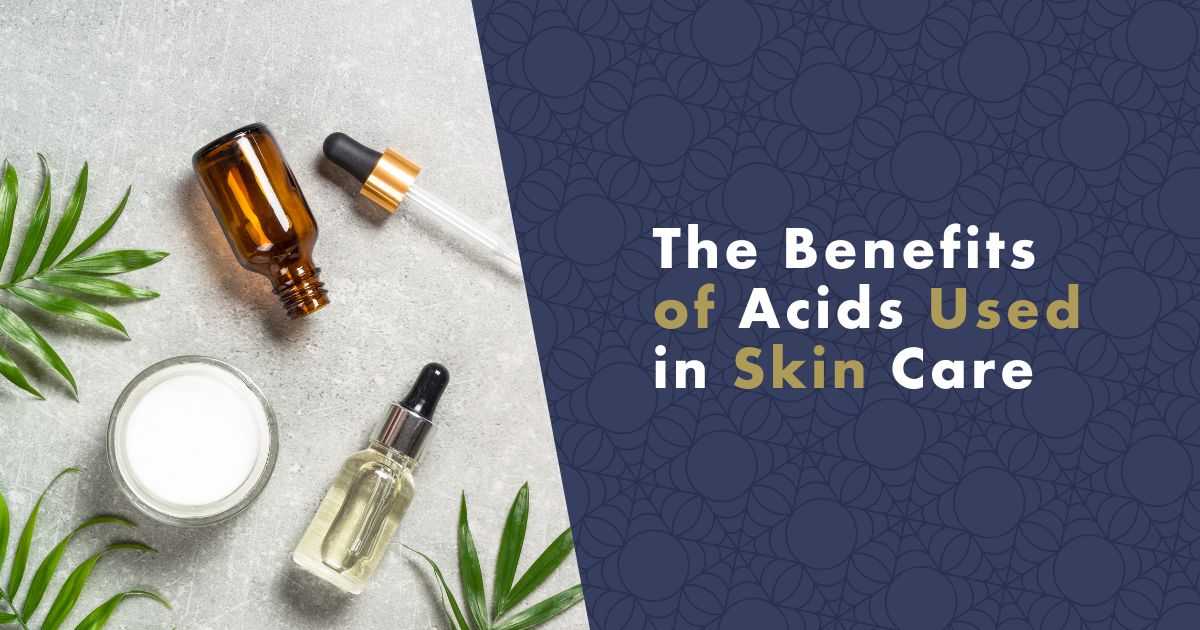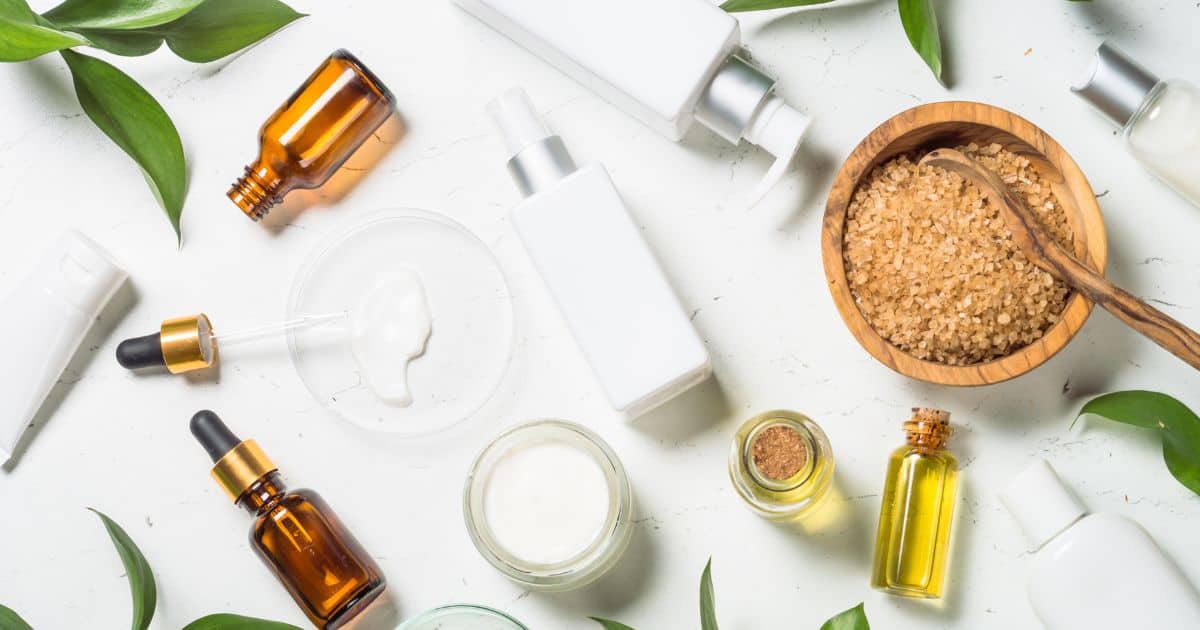If you want to maintain a youthful appearance, taking care of your face is inevitable. The sooner you start, the better. Over time, the skin loses its elasticity and wrinkles start to appear. Preventing them should become a daily routine from the age of 25. Which nutrients should you definitely not miss? And what is the role of acids in cosmetics?

Acids in Cosmetics Help with Wrinkles, Hydration, and Acne
When you buy one of the cosmetic products for facial care, you may find in its composition that it contains AHA acids (alpha hydroxy acid), BHA (beta hydroxy acid), or PHA (poly hydroxy acid). These are fruit acids with revitalizing effects on the skin, capable of addressing signs of aging and various skin issues.
Their main advantage is that they allow other active ingredients to penetrate deeper into the skin, thus nourishing it more effectively. These acids are often used for the treatment of hyperpigmentation, acne, and premature skin aging. They can also combat enlarged pores, pigmentation spots, fine lines, acne scars, and everything that can be alleviated by more frequent skin renewal.
Tip: Read about what works on pigmentation spots.
Another task of acids is skin exfoliation, during which dead skin cells, sebum, and various impurities are removed. This makes the skin appear brighter and more youthful at first glance.
Thanks to their exfoliating effects, acids are often called chemical peels and are much gentler on the skin than physical peels, such as scrubs or products with abrasive particles that mechanically remove the dead skin layer.
AHA Acids
If you want to take thorough care of your face, it's worth getting acquainted with cosmetic ingredients that allow you to do so. AHA acids are the most commonly used acids in cosmetics. They are water-soluble, which means they don't penetrate deep into the skin and work only on the surface. Their main function is exfoliation, which means getting rid of dead skin cells. They are categorized by the size of their molecules: the smaller the molecule, the deeper it can penetrate into the skin.
AHA acids support collagen production, an essential skin component responsible for its elasticity. If collagen is lacking, the skin will be drier or duller and prone to wrinkles. AHA acids remove excess sebum from the skin and regulate its production.
#produkty#https://www.nanospace.store/search/?string=lactic+acid
Glycolic Acid
It has the smallest molecules, allowing it to penetrate the deepest into the skin and is, therefore, the most effective of AHA acids. It is usually derived from sugarcane but can also come from beets, melons, grapes, or pineapples. Being the most effective, it is also the most irritating, so it must be used with caution.
Lactic Acid
As the name suggests, lactic acid comes from milk. This acid is gentler, promotes skin hydration, and is suitable for introducing the skin to acids.
You can find lactic acid in:
Mandelic Acid
Mandelic acid has the largest molecules among AHA acids, making it the gentlest for the skin. It is suitable for acclimating the skin. It helps with hyperpigmentation and treating adult acne.
Results may take time, but if you have sensitive skin, this is an option for getting used to acids.

Tip: Learn how to properly cleanse your skin in our next article.
Citric Acid
It is not used on its own but serves as a preservative. It brightens tired skin and protects it from the harmful effects of free radicals.
You can find citric acid in products such as:
- Refreshing Hair and Skin Water with Liposomes
- Intensive Moisture Mask - Moisture Protect 48H
- Nourishing Hydrating Mask for Tired Skin 40 +
- Skin Recovery Cream 50+
- Gentle Cleansing Milk Nafigate
- Hydralift Complex Eye Cream
BHA Acids
Among the most well-known BHA acids is salicylic acid. BHA acids are oil-soluble, allowing them to penetrate the skin more deeply than AHA acids and dissolve pore contents. It has strong antibacterial properties, making it a frequent recommendation for problematic and acne-prone skin.
Tip: Try [n]Acne Nanofiber Patches for targeted skin treatment by nanoSPACE Cosmetics.
It is particularly useful in caring for young, acne-prone skin because it can manage the removal of skin oil. Skin oil can clog pores and lead to pimples, blackheads, and acne. It is also popular in cosmetic products because it alleviates skin irritation and has anti-inflammatory effects. BHA acid creams are suitable for teenagers, but they can also benefit adults with a tendency toward acne and oily skin.
You can find salicylic acid, for example, in:
- Acne Cream NAFIGATE - Acne Cream NAFIGATE
- Acne Mask
- Hyaluron Essential Serum NAFIGATE
- Brightening Dry Sheet Nanofiber Face Mask [n]fibrecare
- Peel-off Cleansing Bamboo Charcoal Mask NAFIGATE
It's important to know that you should always use only one product with salicylic acid in your skincare routine. Otherwise, it can excessively dry out your skin. For oily skin, a maximum of 2 products is recommended. Even so, it's advisable to approach skincare with caution.
#produkty#https://www.nanospace.store/search/?string=salicylic+acid
PHA Acids
For some skin types, AHA and BHA acids can be too intense. In such cases, it's better to opt for products with PHA acids. These acids are essentially the newest discoveries that function similarly to AHA acids but are much gentler, making them the most suitable for sensitive skin. They can also be used by individuals with eczema or frequent skin irritation.
The advantage of PHA acids is that they are often antioxidant, protecting the skin from free radicals, soothing the skin, supporting the skin's natural barrier, and attracting moisture into the skin, thus promoting hydration.
Lactobionic Acid
Obtained from lactose in cow's milk, it acts as a moisturizer, antioxidant, and skin soother.
You can find lactobionic acid, for example, in:
- Anti-aging Dry Sheet Nanofiber Face Mask [n]fibrecare
- Set of Anti-aging Dry Sheet Nanofiber Face Masks 7+1 for free
- 6-Pack Anti-aging Dry Sheet Nanofiber Face Masks
- 5-Piece Starter Pack Dry Sheet Nanofiber Mask
Galactose
Sugar used in the synthesis of glycosaminoglycans, collagen, and cell migration, promoting wound healing.

Tip: Read about How to Fight the First Wrinkles on the blog.
Gluconic Acid (Gluconolactone)
Gluconolactone is one of the most common PHA acids (polyhydroxy acids) used in skincare and is commonly found in skin cells. It functions similarly to AHA and BHA acids (such as glycolic, lactic, and salicylic acids) by dissolving the "glue" that holds dead skin cells together.
You can find gluconic acid, for example, in:
- Soothing Dry Sheet Nanofiber Face Mask for Sensitive Skin [n]fibrecare
- Moisturizing Dry Sheet Nanofiber Face Mask [n]fibrecare
- 5-Piece Starter Pack Dry Sheet Nanofiber Mask
The primary difference is that gluconolactone has a large molecule, so it can't penetrate deep into the skin - which means it's much less irritating than traditional skin acids. It is therefore suitable for those with sensitive skin and also has antioxidant and anti-inflammatory properties.
#produkty#https://www.nanospace.store/search/?string=gluconolactone
Other Acids Used in Cosmetic Products
Finally, there are substances that essentially have the word "acid" in their name but are not considered acids. This is because they do not exfoliate the skin and, therefore, cannot be classified as AHA, BHA, or PHA acids.
Azelaic Acid
An anti-inflammatory and antibacterial acid that helps with acne, pigmentation, and skin texture.
You can find azelaic acid, for example, in:
- Brightening Dry Sheet Nanofiber Face Mask [n]fibrecare
- 9-Pack Moisturizing Dry Sheet Nanofiber Face Masks
- 6-Pack Anti-aging Dry Sheet Nanofiber Face Masks
Lipoic Acid (Alpha Lipoic Acid)
It is a powerful antioxidant that brightens the skin and improves its structure.
Hyaluronic Acid
Hyaluronic acid, also known as hyaluronan, is a clear, viscous substance naturally produced by your body. It is most abundant in the skin, connective tissue, and eyes. As a building block of cells, it directly affects the quality and elasticity of the skin. It promotes wound healing and maintains hydration throughout the body.
This compound is renowned for its anti-aging, hydrating, and healing properties. Its molecules have a round shape and can absorb a vast amount of water. Thus, hyaluronic acid exists in the body in the form of a gel that gives tissues the ability to absorb shocks. It is, therefore, not surprising that this substance is a fundamental component of joint fluid.
#produkty#https://www.nanospace.store/day-creams/
Tip: Read about 7 Reasons Why Your Skin Needs Hyaluronic Acid.
You can find hyaluronic acid, for example, in:
- Hyaluron Eye Serum 10ml
- Moisturizing Anti-Wrinkle SPF 15 - Hyaluron Day Cream
- Hyaluron Peptide Serum 15 ml
- Hyaluron CC Cream 50ml - Tinted Cream with Hyaluronic Acid
- Hyaluron Essential Serum NAFIGATE 20ml
- Under-eye Mask for Instant Wrinkle Reduction – Nano Eye Lift 6+2
This acid is suitable for women and men of all age groups and is suitable for all skin types, especially mature, dry, dehydrated, sagging, and aging-prone skin, but it also helps with acne-prone and problematic skin.
For preventive effects, it is recommended to use hyaluronic acid from the age of 25, as it naturally diminishes from cells and the skin loses its original properties. There is no problem using it earlier if your skin shows signs of aging.
Vitamin C (L-ascorbic acid)
Vitamin C is known for its brightening effects and is excellent not only for days when you feel tired and your skin looks dull but also before a party when you want your skin to look healthy and youthful.
Spots on the face or red skin can be the result of various factors, including inflammatory skin conditions (e.g.,eczema and rosacea), sun damage, and hormones. Vitamin C definitely minimizes redness due to its anti-inflammatory and antioxidant properties.
Tip: Read about Vitamin C and Its 7 Proven Effects on the Skin.
You can find vitamin C, for example, in:
- Moisturizing Dry Sheet Nanofiber Face Mask [n]fibrecare
- Vitamin C Rejuvenating Dry Sheet Nanofiber Face Mask [n]fibrecare
- Brightening Dry Sheet Nanofiber Face Mask [n]fibrecare
- Regenerating Oil for Skin and Hair - Antioxidant oil NAFIGATE 50ml
- Intensive Moisture Mask - Moisture Protect 48H 50ml
When and How to Use Acids
It is very important to use acids in the evening and to use a cream with SPF protection daily because acids increase the skin's sensitivity to sunlight. Always apply acids to dry skin.
If the acid burns or if your skin starts peeling the next day, you have exceeded the acid concentration, so it's necessary to take a break. Then try to reduce the concentration, for example, by using fewer products or applying a non-exfoliating product as a base, which will slightly lower the concentration.
Never use acids on irritated or damaged skin. Also, do not combine acids with vitamin C or retinols in one routine (combining them with retinols is possible after longer use of both). Instead, they can be combined with hyaluronic acid.
#produkty#https://www.nanospace.store/day-creams/
Tip: Read about the Best Collagen for Skin, Hair, and Joints.
Sources:
- Efficacy and safety of a facial serum and a mask containing salicylic acid and lipohydroxy acid in acne management: A randomized controlled trial
- Hyaluronic acid: A key molecule in skin aging
- Functions of hyaluronan in wound repair
- Interactions of hyaluronic acid with the skin and implications for the dermal delivery of biomacromolecules
- Efficacy of a New Topical Nano-hyaluronic Acid in Humans
- The efficacy of glycolic acid, salicylic acid, gluconolactone, and licochalcone A combined with 0.1% adapalene vs adapalene monotherapy in mild-to-moderate acne vulgaris: a double-blinded within-person comparative study
- Papakonstantinou, E., Roth, M., & Karakiulakis, G. (2012). Hyaluronic acid: A key molecule in skin aging. Dermato-endocrinology, 4(3), 253-258. doi: 10.4161/derm.21923
- Boregowda, S. V., Booker, C. N., & Smith, M. K. (2019). Topical Hyaluronic Acid as a Dressing for Dermal Wounds. Advances in wound care, 8(6), 250-257. doi: 10.1089/wound.2017.0765
- Boucetta, K., Charrouf, Z., Derouiche, A., Rahali, Y., and Bensouda, Y. (2014). Skin hydration in postmenopausal women: argan oil benefit with oral
and/or topical use. Menopause Review/Przegląd Menopauzalny, 13(5), pp.280-288. https://doi.org/10.5114/pm.2014.46470 - Jiang, D., Liang, J., & Noble, P. W. (2007). Hyaluronan in tissue injury and repair. Annual review of cell and developmental biology, 23, 435-461. doi: 10.1146/annurev.cellbio.23.090506.123337
- Advances for delivery, efficiency and stability. Nanomedicine: Nanotechnology, Biology and Medicine, 24, 102117. ISSN: 1549-9634. DOI: 10.1016/j.nano.2019.102117
- Richelle, M., Steiling, H., & Castiel, I. (2009). Bioavailability and Skin Bioefficacy of Vitamin C and E. In A. Tabor & R.M. Blair (Eds.), Personal Care & Cosmetic Technology: Nutritional Cosmetics (pp. 115-138). William Andrew Publishing. ISBN: 9780815520290. DOI: 10.1016/B978-0-8155-2029-0.50013-2.



